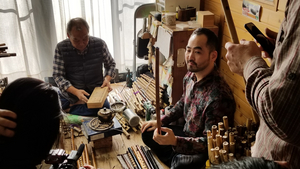Review: SHINOBU
Since its premiere in 2018, the film continues to enjoy critical acclaim in film festivals throughout the world.



May is Asian/Pacific American Heritage Month ~ an opportunity to acknowledge the generations of Asian and Pacific Islanders who have enriched America's history and are crucial to its future development.
Hsuan-Yu Pan, a Taiwanese documentary filmmaker based in New York, gives vibrant sound and imagery to a slice of these diverse cultures and their artistic contributions in SHINOBU.
As is the case with her other projects (two of which were the subject of my recent review @ /phoenix/article/BWW-Review-HEAR-EAT-HOME-KINANS-VISION-AND-MY-MOTHERS-TABLE-at-PanVideo-20210430), SHINOBU focuses on the continuity of tradition over time and space in shaping not only one's cultural identity but also the identity of the cultures of which they become a part.
In 2017, she joined the world-famous Taiko drummer Kaoru Watanabe and a group of Americans in a visit to the Tokyo studio of Ranjo san, a master Japanese bamboo flute maker whose stature with musicians derives from his modification of the instrument's internal structure to correspond to the Western scale.
Her documentation of the exchange between teacher and students emerges as an instructive and enlightening introduction to a unique and highly specialized art form. The camera tracks the meticulous design of the fue (the Japanese flute) during which the intricate attributes of bamboo are exposed and the artists share their formative life stories.
Watanabe, a student too of jazz and classical music and a member of Kodo (a Japanese ensemble dedicated to sharing the power of the drum), reveals to his hosts that, born in the United States, he did not learn Japanese until he was twenty-two. Ranjo san, in turn, shares the story of his lifelong pursuit of the art form ~ making his first flute at the age of eleven and founding his workshop seven years after the devastating Tōhoku earthquake and tsunami. Both evidence an appreciation of the role they play in fostering and preserving their cultural roots.
Both men and the participants are engaged in a profoundly important generational conversation ~ the two-way transmission of cultural data, the exposition of the role of roots in defining identity.
Within the elegant simplicity that one generally assigns to Japanese art there are the subtle lines and shades of past and present that ensure the vitality and adaptability of the art. Pan excels in capturing the moment while the distinctive melodious sounds of the fue resonate in the background.
Footnote: Shinobue is a kind of flute with a high-pitched sound. When it came to naming their daughter, Kaoru thought to name her thus. He and his wife happily compromised instead on Shinobu!
Since its premiere in 2018, the film continues to enjoy critical acclaim in film festivals throughout the world.
Photo credit to Hsuan-Yu Pan
Hsuan-Yu Pan ~ https://www.panvideo.net/ ~ info.panvideo@gmail.com
Reader Reviews

Videos
